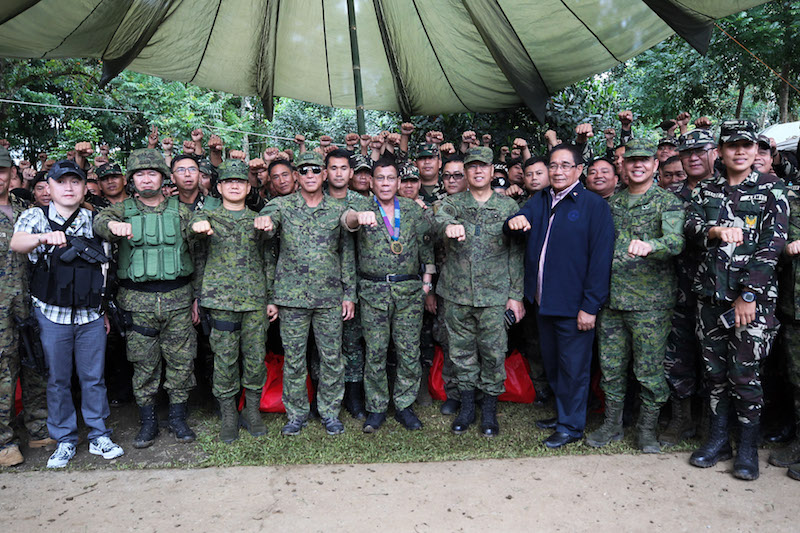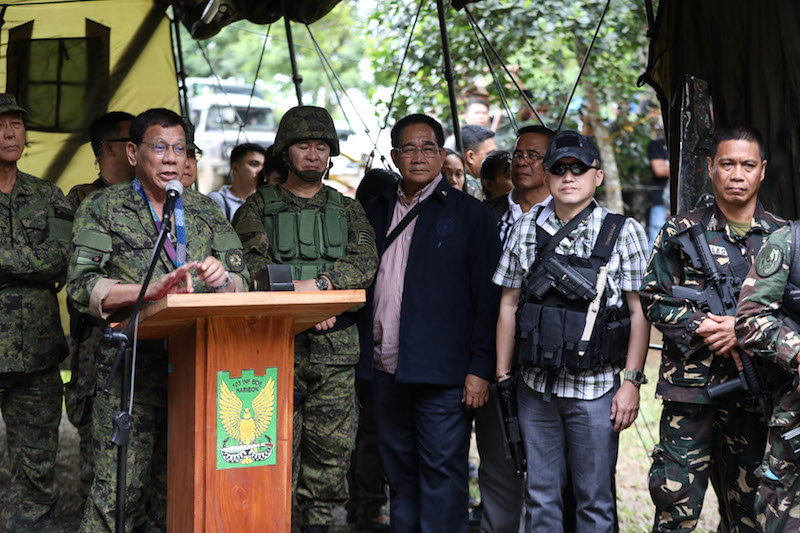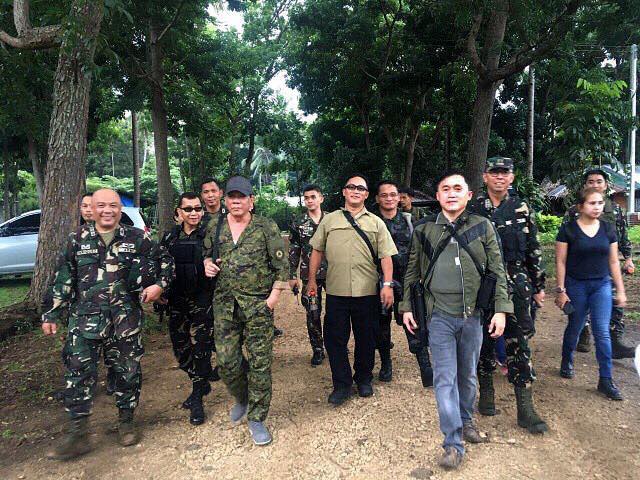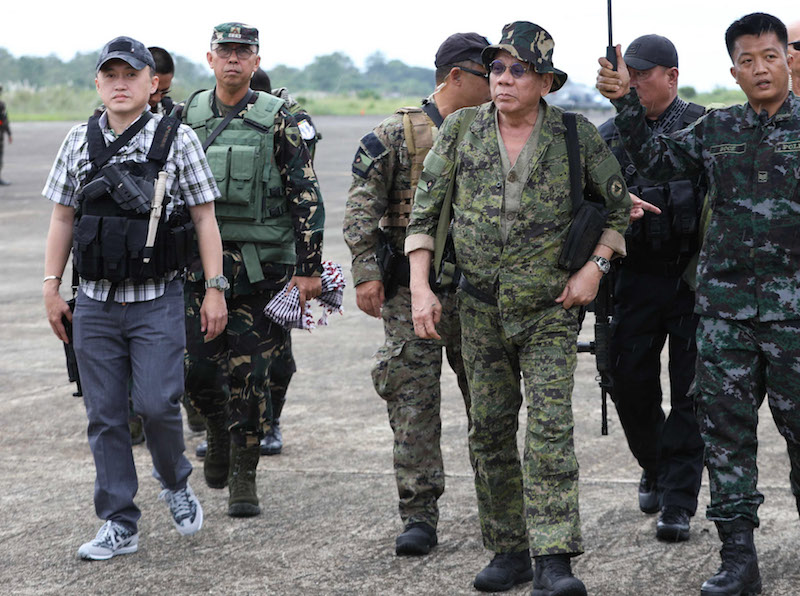DAVAO CITY (MindaNews / 21 July) — President Rodrigo Duterte finally made it to Marawi on Thursday, Day 59 of the Marawi Crisis and on the 59th day also of martial law, revealed for the first time, a personal reason why he declared martial law: to avoid impeachment.
It was his third attempt to visit his troops, after two unsuccessful attempts on June 8 and July 7.
“Because of the critical condition as assessed by your military and the different departments, I had to declare martial law otherwise I will be a candidate for impeachment also. Mas mabigat yan kung pwede akong maalis sa pwesto. Nakakahiya” (That’s more serious if I am removed from my post. What a shame), Duterte told troops assembled at the 103rd Brigade’s Camp Ranao in Marawi City.
 President Rodrigo Duterte finally made it to Marawi City on July 20, after two unsuccessful attempts on June 8 and July 7. Photo by Ace Morandante / PRESIDENTIAL PHOTO
President Rodrigo Duterte finally made it to Marawi City on July 20, after two unsuccessful attempts on June 8 and July 7. Photo by Ace Morandante / PRESIDENTIAL PHOTO
From Moscow where he was on official visit, Duterte declared martial law effective 10 p.m. of May 23, hours after the clashes began in Marawi between government forces and the Maute Group and its allies.
By the time the declaration was announced in a press conference also in Moscow (nearly midnight in the Philippines) by Presidential spokesperson Ernesto Abella, Defense Secretary Delfin Lorenzana and National Security Adviser Hermogenes Esperon, Jr., two soldiers and a policeman had been killed and 12 others were injured but Lorenzana said the situation was “under control.”
At that time, too, not one of the three could say the privilege of the writ of habeas corpus had been suspended. This information would be known only when the President announced it himself when he returned to the country on May 24.
Duterte did not explain why he thought he would be impeached if he did not act on the “critical condition” he claims was the military assessment on May 23.
After all, as early as September 4, 2016 or two days after a night market blast in Davao City killed 15 persons and 70 others, Duterte issued Proclamation 55, declaring a state of national emergency, calling out on the armed forces “to prevent or suppress lawless violence” nationwide.
Among the whereases in the Proclamation was that based on government intelligence reports, “there exist credible threats of further terror attacks and other similar acts of violence by lawless elements in other parts of the country, including the metropolitan areas.”
With a super majority in Congress, Duterte was in no danger of being impeached. On May 15, eight days before the Marawi Crisis started, the Committee on Justice of the House of Representatives threw out an impeachment complaint filed against the President, where he was accused of mass murder in relation to his war on drugs.
The Committee declared the complaint insufficient.
Under Article XI, Section 2 of the 1987 Constitution, the President, Vice-President, members of the Supreme Court and the Constitutional Commissions, and the Ombudsman may be removed from office through impeachment for “culpable violation of the Constitution, treason, bribery, graft and corruption, other high crimes, or betrayal of public trust.”
Emotional
Duterte turned emotional, even pausing to keep his composure, while saying how he gets hurt every night while reading the briefer on the number of casualties in the Marawi war, especially since it was he who declared martial law and ordered them to fight in Marawi.
He said he grieves for soldiers he sent to the war zone and also the civilians.
 President Rodrigo Duterte tells his troops in Marawi City on July 20, 2017 that his life is not more important than the life of a soldier.” Photo by Ace Morandante / PRESIDENTIAL PHOTO
President Rodrigo Duterte tells his troops in Marawi City on July 20, 2017 that his life is not more important than the life of a soldier.” Photo by Ace Morandante / PRESIDENTIAL PHOTO
At the Davao Investment Conference in Davao City on Friday, Duterte told the business sector that he finally made it to Marawi a day earlier and that while he was being briefed on the situation in a room in Camp Ranao, “I almost heard about 16 explosions and the ratatat of the rifles.”
He said they were guarded by “a lot of soldiers and their equipment in the periphery.”
In reply to a question he was asked in Marawi why he insisted on going there despite the danger, Duterte said he replied: “Never mind about the dangers. We are here to die … I came here (Marawi) to die because they are here to die and I will match their fervor. I would like to die, too. Any day is a good day to die so what’s the big deal?”
Duterte said his life “is not more important than the life of a soldier.”
“We are the same. we work for the government. We work in the service of the republic. Like everybody dies. So your life here on the field fighting for this nation is not less important than my life so I have to come here during the war because you’d never see me during celebration time,” he said.
Second version of battle dress attire
Duterte, who arrived mid-afternoon was accompanied by Defense Secretary Delfin Lorenzana, National Security Adviser Hermogenes Esperon, Jr., Presidential Adviser for Military Affairs Arthur Tabaquero, Armed Forces Chief of Staff General Eduardo Año and Army Chief Lt. Gen. Glorioso Miranda.
Duterte was given a briefing on the “military campaign against the local terrorist group and the conditions of internally displaced persons” before he talked to the troops.
The President urged his troops to “continue to fight for your country and know that I will fight for your rights.”
In his report to the President, Brig. Gen. Joselito Bautista, Commander of the Joint Task Force Marawi who had earlier served as chief of Duterte’s Presidential Security Group, said 16 strategically located buildings had been cleared, nine firearms recovered including one M60 General Purpose Machine Gun, one Grenade launcher (burned), one M14 rifle and two M4 carbine rifles.
Lt Col Jo-Ar Herrera, Joint Task Force Marawi spokesperson, said the President’s visit boosted the morale of the military and police who are battling the Islamic State-inspired Maute Group and its allies.
“Very firm and dedicated ang Pangulo sa pagusporta sa operations sa Marawi,” he said, adding his vistit boosted the troops’ fighting spirit.
Duterte was finally able to see the firearms seized by troops from the Maute Group that were on display on June 8 for presentation to him. More firearms, however have been recovered — from 138 as of June 8 to 516 as of July 20.
Photos distributed by the Presidential Photographers Division showed the President wearing a second Duterte version of the battle dress attire (BDA): the same digitized camouflage uniform he wore on July 7 but no longer worn with a gray ball cap and gray suede sneakers.
Duterte introduced his first version of the BDA on July 7, in violation of the AFP’s Uniform Code.
 President Rodrigo Duterte on July 7, at the 2nd Mechanized Brigade in Iligan City after foul weather prevented him from proceeding to Marawi City. PCO PHOTO
President Rodrigo Duterte on July 7, at the 2nd Mechanized Brigade in Iligan City after foul weather prevented him from proceeding to Marawi City. PCO PHOTO
 President Rodrigo Duterte finally made it to Marawi City on July 20, after two unsuccessful attempts due to foul weather on June 8 and July 7. Duterte is seen here at Laguindingan Airport in Misamis Oriental, on his way to board the helicopter for Marawi. Ace Morandante / PRESIDENTIAL PHOTO
President Rodrigo Duterte finally made it to Marawi City on July 20, after two unsuccessful attempts due to foul weather on June 8 and July 7. Duterte is seen here at Laguindingan Airport in Misamis Oriental, on his way to board the helicopter for Marawi. Ace Morandante / PRESIDENTIAL PHOTO
In his photograph taken at Laguindingan airport, where his plane landed from Davao City, Duterte showed a second Duterte version of the BDA. Walking towards the helicopter he was boarding for Marawi, Duterte could be seen wearing his digitized camouflage uniform, sleeves again rolled up, topmost button still open, revealing a buttoned khaki green undershirt and white sando, a black belt partly inside, partly over the top uniform.
This time, he wore black shoes and what in the Armed Forces is referred to as a “lousy hat.”
In Marawi, Duterte’s black belt was worn over the top. He didn’t use the “lousy hat.”
A military source told MindaNews Duterte wore what looks like a “General’s belt” which used to be worn over the BDA but is no longer used now. “We wear the BDA without the belt. The only time we use the belt, which is a ‘pistol belt’ is when you carry a pistol.” (Carolyn O. Arguillas / MindaNews)
